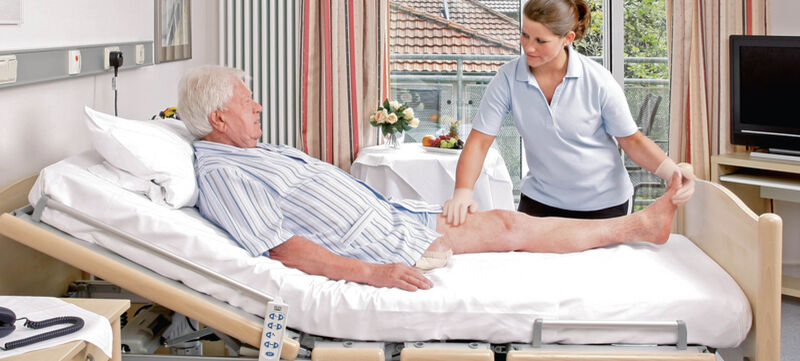Stay mobile
Even while your residual limb is healing, you can prepare for the stay in a rehabilitation clinic with specific exercises. Talk to your doctor or physiotherapist and ask them to show you some important things: Correct positioning in bed so that the muscles and the joint closest to the residual limb do not shorten or stiffen, regular breathing exercises and light movement and mobilisation exercises, which also serve to stabilise the circulatory system. These measures help ensure that you can be fitted with a prosthesis quickly and without problems, so that you can remain mobile and active.
Correct positioning of the stump
Lying still for a long time directly after the operation will certainly be difficult for you. You will probably not be able to turn around on your own in bed yet either. Therefore you should get assistance from nursing staff to reposition yourself several times a day. This repositioning is important, since it ensures that you are as pain-free as possible and also prevents the development of pressures sores.
The correct positioning of your residual limb is important as well. If you are lying on your back, your residual limb should not be propped up on pillows. Also do not let the residual limb hang down while sitting in a wheelchair or on the bed. This could reduce the mobility of your residual limb, and limited mobility of the residual limb means you will not be able to properly control your prosthesis later on. Correct positioning with the joint extended – insofar as this is possible for you – prevents what are called contractions or shortening of the muscles.
What can we do for you?
Contact us for a personal consultation
Speak with an expert at
1300 136 054
Email us enquiries@spao.com.au
Movement exercises
Sitting up in bed on your own and transferring to a wheelchair will probably be difficult for you at first. But with some practice, you will soon master this. Your physiotherapist should give you detailed instructions. Often there are straps or handles on the bed which you can use for assistance. Soon you will also get up for the first time. Since the familiar balancing weight of the amputated limb will be missing, you should expect balance problems at first. A walker or other walking aid can initially help you keep your balance after a leg amputation.
Mobility training
To prepare your body optimally for the subsequent treatment steps, exercises to strengthen the torso, arm and leg musculature are highly recommended. You should talk to your doctor or therapist to determine which exercises are suitable. The exercises can be performed with light weights and therapy bands, from a lying, sitting or standing position. The residual limb should also be included in the exercises. These movement exercises prevent stiffening of the muscles and joints. Also familiarise yourself with movement patterns that are initially unfamiliar with the amputated leg. Your physiotherapist should show you all exercises and check that you are doing them correctly. He or she can advise you regarding the right exercises at the respective time.










